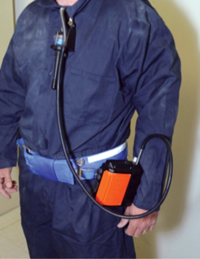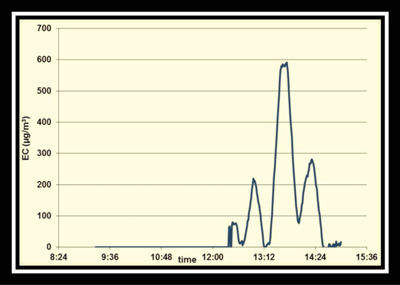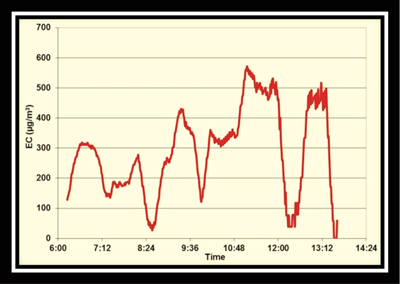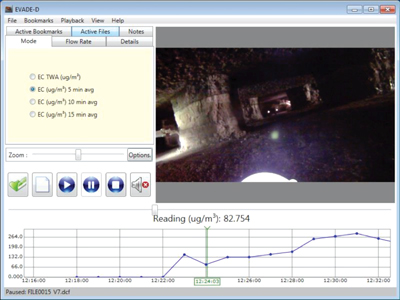In the world of worker exposure measurement, the gold standard is a wearable instrument that monitors in real time. For this purpose, the National Institute for Occupational Safety and Health (NIOSH) has developed a real-time diesel particulate matter (DPM) monitor. This monitor provides miners with timely information to identify the major factors contributing to overexposures, which can be helpful in reducing DPM exposures by allowing control interventions to be deployed immediately. This article evaluates the accuracy of this monitor (the FLIR Airtec) and reveals how it can be used as a tool for assessing and controlling DPM exposures.
 |
| Figure 1—The FLIR Airtec: a real-time DPM monitor. |
Background on Measuring DPM Exposure
Exposure to DPM is a health concern for miners because it has been classified as a carcinogenic to humans by the International Agency for Research on Cancer (IARC) (IARC 2012). Since underground miners work alongside diesel equipment in a confined environment, they can be exposed to elevated concentrations of DPM. Therefore, the Mine Safety and Health Administration (MSHA) promulgated a rule to limit DPM exposures of metal/nonmetal underground miners (MSHA 2006).
The standard method for determining DPM exposures is to collect the particulate onto a filter for an entire shift. The sample is then sent to a laboratory to be analyzed for elemental carbon (EC) and total carbon (TC) using NIOSH method 5040. Although an accurate method for determining DPM exposures, NIOSH method 5040 only provides the average concentration over an entire working shift and can take weeks to obtain results. While this approach does determine that an overexposure has occurred, it fails to provide critical information about cause or prevention.
Conversely, real-time measurement would provide miners with timely information to identify the major factors contributing to overexposures. This information would allow control interventions to be deployed immediately. To this end, NIOSH developed an instrument to measure real-time EC exposure via laser extinction (Noll et al. 2013). EC was chosen as the analyte because it makes up a major portion of DPM, is not prone to interferences, and is one of the surrogates used by MSHA for compliance sampling. Filter-based laser extinction (which employs absorption and scattering) was determined to be a feasible method because EC concentrations can easily be correlated to laser absorption. In addition, this simple technique can be adapted into a small instrument. This instrument, the FLIR Airtec (see Figure 1), is now commercially available.
The Airtec has been shown to be accurate in both the laboratory and field. It was found to be within 10% of the standard method in the laboratory (Noll et al. 2013) and was equivalent to the standard method when measured side-by-side in extensive field samples (Noll and Janisko 2013). The only observed influences from other aerosols on the Airtec reading can occur when a miner is smoking inside a cab, which can be avoided if the miner simply does not smoke inside the cab during sampling.
Using Real-time Measurement for Administrative Controls
To protect blasters, surveyors and other miners who must work outside of cabs, some mines are implementing administrative controls to reduce DPM exposures. These administrative controls include operating high-emitting vehicles on different shifts or downstream from miners who work outside of enclosed cabs, limiting the number of vehicles in an area, and spot checking areas before miners enter.
The Airtec provides a tool to help administer these controls more efficiently. It serves as a measurement tool for spot checking, which cannot be performed without a real-time monitor. It also helps ensure that DPM overexposures do not occur—even for administrative controls that do not necessarily require real-time monitoring such as limiting the number of vehicles in an area or operating some vehicles only downstream of blasters. When a mine attempts to implement these types of administrative controls without the Airtec, the concentration of DPM can be elevated for some time before it is noticed that too many vehicles are operating upstream of the miners of concern. But with the Airtec, the DPM concentration can be continuously monitored. Blasters, surveyors or other designated miners can then know quickly when elevated DPM concentrations exist in certain areas.
 |
 |
| Figure 2a—(left) A chart representing peaks in DPM concentrations due to an open cab door. Figure 2b (right) a chart representing real-time DPM concentrations being continuously above the final PEL inside a cab. |
Evaluating Enclosed Cabs and Control Rooms with Real-time DPM Measurements
The real-time feature of the Airtec allows for the evaluation of an enclosed cab system without the influence of confounders such as opening and closing doors and windows. Enclosed cabs can be very effective (>90%) in protecting miners from DPM exposures. However, over time, factors such as a loss in cab integrity or cab filter degradation can cause higher concentrations of DPM to penetrate into the cab. Periodically, researchers and operators evaluate cabs to determine their effectiveness at reducing DPM concentrations. In addition, cabs are evaluated to determine the effectiveness of alterations to the cab system and the use of different types of filters. The problem with using the NIOSH method 5040 for evaluating cabs is that the results include effects from work practices such as opening and closing doors. This could result in inaccurate data about the cab system itself. Because it is a real-time monitor, the Airtec allows researchers and operators to account for these work practices.
To demonstrate, when using the standard method (NIOSH method 5040) for evaluating the effectiveness of some cabs for reducing DPM over a number of days at a limestone mine, the DPM reduction efficiencies ranged from 46% to above 95% (Noll et al. 2014). This large range of efficiencies was probably because under real-time operating conditions, operators periodically need to open their cabs (for example, to communicate with other miners or to perform duties outside of the cab). When a door or window is open, the cab compartment becomes contaminated. Therefore, it can be deduced that the efficiency for each day was probably influenced by how often and how long the door and windows in the cab were opened.
At the same limestone mine, the real-time information from the Airtec took into account the work practices and provided the efficiency of the cab system itself. Airtecs were used to take samples inside and outside of the cab, and a pressure monitor inside the cab was used to determine when the door or window was open. A positive pressure indicated that the cab was sealed, while a pressure of zero revealed that a door or window was open. The real-time concentrations of the Airtecs were averaged only at the times of the day when the cab door and window were closed (as revealed by the pressure data), and these concentrations were used to determine the reduction efficiency. This procedure resulted in the determination of reduction efficiencies (consistently above 90%) only when the cab was sealed (Noll et al. 2014). Slightly modifying this procedure, another mine had the cab operator take notes indicating when the cab door or window was open instead of using a pressure monitor.
The real-time DPM measurements can also be utilized to provide a “quick and dirty” evaluation of the cab system. After the inside of the cab is measured for an entire shift with the Airtec, both the eight-hour time-weighted average (TWA) and the real-time graph should be assessed. When the eight-hour TWA concentration is above the final MSHA-permissible exposure limit (PEL) (about 120 µg/m3 EC or 160 µg/ m3 TC), the real-time graph helps differentiate whether an inefficient cab or work practice is the cause. If elevated concentrations of DPM are due to an open door or window, peaks in the graph should be observed (see Figure 2a), because the concentration of DPM should increase when the door is open and then decrease once the cab is sealed. If there are few peaks and the concentration of DPM is consistently above the PEL (see Figure 2b), then it can be assumed there are issues with cab integrity. Using the above technique as part of the evaluations described, one mine was able to detect that a new cab was leaking. This was confirmed at the maintenance shop using a smoke bomb test, and the cab was immediately scheduled for repair.
Using Real-time Measurement for Evaluating Ventilation
The Airtec has also been used to perform some spot checking to determine the effects of ventilation changes and the need for ventilation in specific areas of the mine. For example, a mining engineer at one mine carried the Airtec and measured the DPM concentrations in different areas. Due to high concentrations at one of the faces, he was able to determine that a vent bag needed to be moved in order to provide adequate ventilation to a working area (Lethbridge and Good 2010). At two other mines, though the exposures of the blasters were within compliance for the eight-hour TWA, the short-term concentration of DPM around the blasters was greater than the MSHA PEL. The blasters were not out of compliance because they were loading faces only part of the shift; however, the real-time data revealed that they could have been out of compliance if they had to load additional faces. Therefore, these mines began investigating ventilation techniques to reduce the DPM concentrations at the face.
Using a Video Recording System to Assess Sources of DPM Exposures NIOSH has recently developed a video monitoring system, called “Helmet-CAM,” where a miner wears a camera and a real-time aerosol monitor while performing work tasks (Cecala et al. 2013). Whenever the work tasks are completed, the video and real-time monitor data are downloaded, then the downloaded files are processed by a software program (EVADE, www.cdc.gov/niosh/mining/Works/coversheet1867.html) developed by NIOSH. The software program combines the two files and thus aligns the contaminant concentration measurements with the video that documents the task being performed. This method has been successful in identifying specific work tasks and work environments that can cause elevated exposures to dust. Using this information, controls can be implemented to reduce respirable dust exposures.
This type of assessment tool can now be used to determine elevated exposures to DPM with the NIOSH-developed software and the Airtec. For example, the Helmet-CAM can be advantageous for determining sources of DPM exposures for mobile workers such as surveyors and blasters. Figure 3 shows a still frame of the video and DPM concentration graph generated when a NIOSH researcher demonstrated the Helmet-CAM at a limestone mine. As seen in the graph at the bottom of the figure, the concentration of EC was about 83 µg/m3 at the time this picture was captured. As can be seen in the picture, a loader, truck, and scaler were working near the researcher at that time, indicating possible DPM sources. This same approach can be used to help determine the sources of DPM exposures to mobile workers.
 |
| Figure 3—A still picture of the merged video footage and DPM concentration graph from the Helmet-CAM |
Conclusion
The standard method for determining DPM concentrations in underground mines is time consuming and provides limited data. Therefore, NIOSH developed an instrument, shown to be accurate in both the lab and the field, for measuring real-time DPM. The FLIR Airtec is a commercially available monitor that can be a valuable tool not only for assessing DPM exposures but also for allowing controls to be more effective in reducing these exposures. Some examples described in this article were evaluating enclosed cabs, adjusting ventilation, implementing more effective administrative controls, and assessing exposures in conjunction with a helmet-worn video recording system. While this list is not all-inclusive, it demonstrates some of the potential benefits of the Airtec for mine operators.
Disclaimer
Mention of a company name or product does not constitute an endorsement by the NIOSH. The findings and conclusions in this report are those of the authors and do not necessarily represent the views of the NIOSH.
References
- Cecala AB, Reed WR, Joy GJ, Westmoreland SC, O’Brien AD (2013). Helmet- Cam: Tool for assessing miners’ respirable dust exposure, Mining Engineering, Vol. 65, No. 9, pp. 78?84.
- IARC (International Agency for Research on Cancer). IARC: Diesel Engine Exhaust Carcinogenic. (Press Release No. 213) June 12, 2012. Accessed at http://press.iarc.fr/pr213_E.pdf on January 15, 2013.
- Lethbridge T., Good M. (2010). A multi-focus approach to DPM reduction at the Greens Creek mine. In: Hardcastle S., McKinnon DL. Proceedings of the 13th U.S./North American Mine Ventilation Symposium, Sudbury, Ontario, Canada: 65 71.
- MSHA (2006). 30 CFR Part 57 Diesel Particulate Matter Exposure of Underground Metal and Nonmetal Miners; Final Rule. Mine Safety and Health Administration, Fed. Reg. vol. 71, No. 96, 28924.
- Noll JD, Janisko S., Mischler S. (2013). Real-Time Diesel Particulate Monitor for Underground Mines, Anal. Methods 5 (12), 2954–2963.
- Noll JD, Janisko S (2013). Evaluation of a Wearable Monitor for Measuring Real-Time Diesel Particulate Matter Concentrations in Several Underground Mines, Journal of Occupational and Environmental Hygiene, 10:12, 716-722.
- Noll JD, Cecala A, Organiscak J, Rider J. (2014) Effects of MERV 16 filters and Routine Work Practices on Enclosed Cabs for Reducing Respirable Dust and DPM Exposures in an Underground Limestone Mine, Mining Engineering, 2014, Vol. 66, No. 2, pp 45-52.
James Noll, Andy Cecala, John Organiscak and Sam Janisko are researchers working with the National Institute for Occupational Safety and Health, Office of Mine Safety and Health Research, located in Pittsburgh, Pennsylvania, USA. Noll can be reached at +1-412-386-6828 (E-mail: JIN1@cdc.gov).









